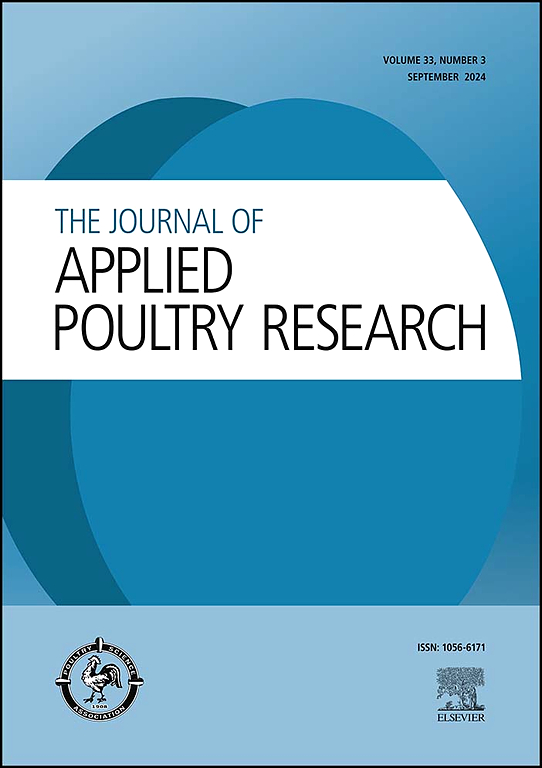Circadian rhythm of locomotor activity and body temperature in free-range laying hens as measured by triaxial accelerometers and subcutaneous biologgers
IF 2
3区 农林科学
Q2 AGRICULTURE, DAIRY & ANIMAL SCIENCE
引用次数: 0
Abstract
Biosensors are essential tools for monitoring temperature in poultry because they provide real-time data that can enhance animal welfare and productivity. The aim of this study was to evaluate the use of triaxial accelerometers and subcutaneous biologgers to monitor of locomotor activity (LA) and body temperature (BT) in free-range laying hens, to explore their potential for assessing circadian patterns relevant to welfare monitoring. Five hens were fitted with a harness that carried an accelerometer to record LA for 6 d. In addition, hens received a surgically implanted biologger to record BT every 15 min. Animals were housed indoors that had an artificial photoperiod (16L:8D) and an adjacent outdoor pen. Hen BT decreased between 1900 h and 2300 h, and was lowest 30 min before lights turned off at 2330 h. From that moment, BT increased throughout the night and until 0900 h in the morning; after which, it remained stable until the evening. Animals remained practically motionless during darkness, and began moving immediately after lights turned on. BT and LA exhibited a 24-h circadian rhythm. There was a significant correlation between BT and LA (P < 0.01), but BT was not correlated with ambient T. LA was correlated with indoor and outdoor ambient T (P < 0.01). In conclusion, free-range laying hens exhibited clear circadian rhythms in LA and BT, which were synchronized with the light-dark cycle. Ambient T influenced LA, which was correlated with BT. Those findings can contribute to the optimization of management practices that are intended to maximize welfare and productivity.
用三轴加速度计和皮下生物学仪测量散养蛋鸡运动活动和体温的昼夜节律
生物传感器是监测家禽体温的重要工具,因为它们提供的实时数据可以提高动物福利和生产力。本研究的目的是评估使用三轴加速度计和皮下生物学家来监测自由放养蛋鸡的运动活动(LA)和体温(BT),以探索它们在评估与福利监测相关的昼夜节律模式方面的潜力。5只母鸡被安装了一个带加速度计的线束,连续6天记录LA。此外,母鸡每15分钟接受一次手术植入的生物学家记录BT。动物被安置在室内,有一个人工光周期(16L:8D)和一个相邻的室外围栏。随后,BT在1900 ~ 2300 h之间下降,在2330 h熄灯前30 min达到最低。此后,BT在整个夜间增加,直到早上0900 h;此后,它一直保持稳定,直到晚上。动物在黑暗中几乎一动不动,灯亮后立即开始活动。BT和LA呈24小时昼夜节律。BT与LA呈极显著相关(P < 0.01),而BT与环境T不相关(P < 0.01), LA与室内和室外环境T相关(P < 0.01)。综上所述,散养蛋鸡在LA和BT中表现出明显的昼夜节律,且昼夜节律与光暗周期同步。环境T影响LA,而LA与BT相关。这些发现有助于优化旨在最大化福利和生产力的管理实践。
本文章由计算机程序翻译,如有差异,请以英文原文为准。
求助全文
约1分钟内获得全文
求助全文
来源期刊

Journal of Applied Poultry Research
农林科学-奶制品与动物科学
CiteScore
4.10
自引率
10.50%
发文量
80
审稿时长
104 days
期刊介绍:
The Journal of Applied Poultry Research (JAPR) publishes original research reports, field reports, and reviews on breeding, hatching, health and disease, layer management, meat bird processing and products, meat bird management, microbiology, food safety, nutrition, environment, sanitation, welfare, and economics. As of January 2020, JAPR will become an Open Access journal with no subscription charges, meaning authors who publish here can make their research immediately, permanently, and freely accessible worldwide while retaining copyright to their work. Papers submitted for publication after October 1, 2019 will be published as Open Access papers.
The readers of JAPR are in education, extension, industry, and government, including research, teaching, administration, veterinary medicine, management, production, quality assurance, product development, and technical services. Nutritionists, breeder flock supervisors, production managers, microbiologists, laboratory personnel, food safety and sanitation managers, poultry processing managers, feed manufacturers, and egg producers use JAPR to keep up with current applied poultry research.
 求助内容:
求助内容: 应助结果提醒方式:
应助结果提醒方式:


